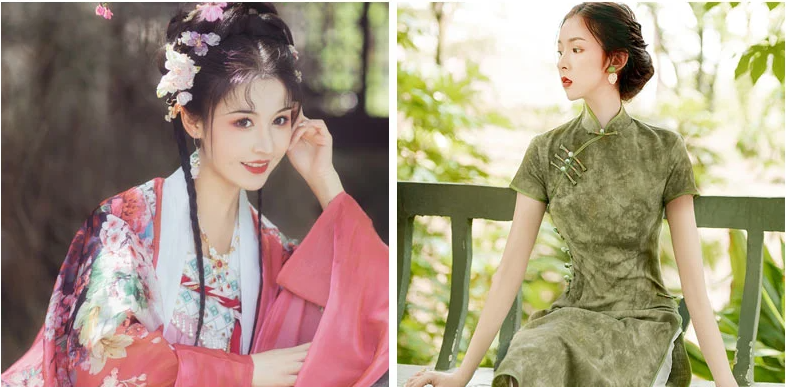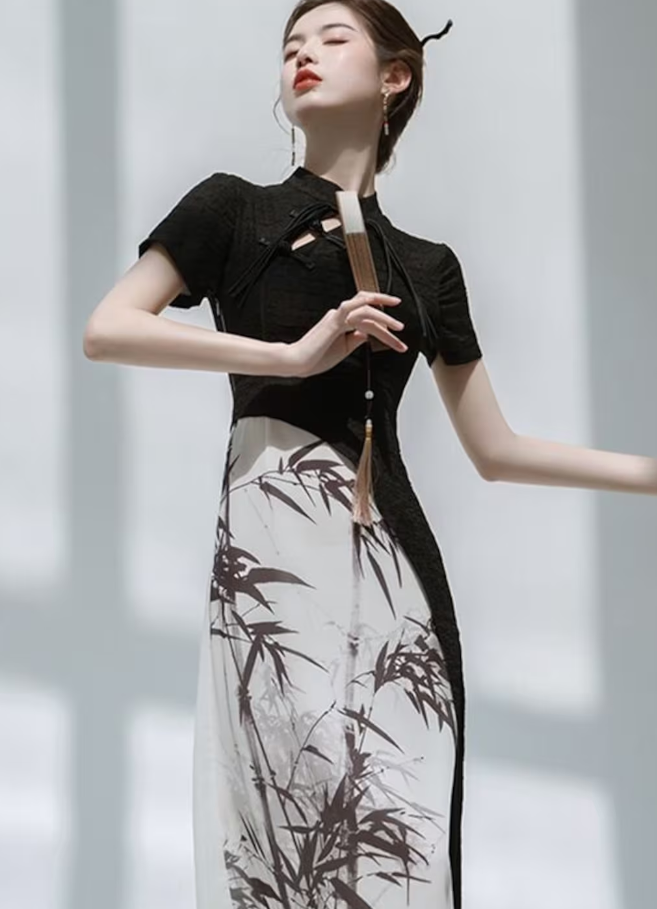The Qipao is a form-fitting, one-piece Chinese dress that originated in the 1920s, while Hanfu refers to traditional Chinese garments with diverse styles that date back to ancient China.
Historical Background
Origin of Qipao
The Qipao, also known as the Cheongsam in some regions, traces its roots back to the Manchu-ruled Qing Dynasty, which lasted from 1644 to 1912. The Manchu people had their own traditional dress, which evolved into what we recognize today as the Qipao. Initially, this attire was quite loose and had a straight cut to conceal the figure, quite unlike the form-fitting version popular today. Around the 1920s and 1930s, particularly in cosmopolitan areas like Shanghai, the Qipao underwent a transformation. Designers started making it more tailored to the female form, adding slits on the sides and using luxurious materials like silk and brocade.
For a more detailed understanding of its transformation, you can visit the Qipao Wikipedia page.

Origin of Hanfu
Hanfu is the traditional attire of the Han Chinese, the ethnic majority in China. The term “Hanfu” literally means “Han clothing,” and its history spans more than three millennia. The Hanfu takes inspiration from the dresses worn during different Chinese dynasties, including the Zhou, Han, Tang, and Ming. Each period contributed unique elements to Hanfu, like the ‘Ru’ from the Zhou dynasty or the ‘Shenyi’ from the Han dynasty. These pieces often consist of a top and a bottom, which could be either a skirt or pants. During formal occasions, additional layers or accessories like robes, sashes, and ornamental headpieces might be added.
For additional historical details, check the Hanfu Wikipedia page.
Design Elements
Structure and Cut of Qipao
The Qipao captivates with its tailored elegance, designed to accentuate the female form. Traditionally, a Qipao features a high, mandarin collar, snugly fitted waist, and side slits that offer ease of movement. The dress typically has a zipper or a series of intricate frog closures—knots made from braided cord—that run diagonally from the right shoulder down to the side. The choice of fabrics is usually luxurious, including silk, brocade, and velvet, often with elaborate patterns or embroidery. You can see these design elements on full display in popular fashion shows and even in Hollywood, as a symbol of exotic femininity and timeless grace.
For more information on the structure and intricacies of the Qipao, visit the Qipao Wikipedia page.
Structure and Cut of Hanfu
Hanfu, on the other hand, is designed for both form and function, capturing the elegance of traditional Chinese aesthetics. Unlike the form-fitting Qipao, Hanfu offers a looser, more flowing silhouette. It typically consists of a top (“yi”) and a bottom, which can be a skirt (“qun” or “chang”) or trousers (“ku”). These garments often feature wide sleeves and use sashes (“dai”) instead of buttons or zippers to secure the clothing. The Hanfu also has various styles and layers like the robe (“pao”), collarless gown (“shan”), and narrow-cuffed robe (“ao”) which can be combined based on the occasion. Ornamental elements like embroidery, patterns, and silk brocade are also common.
For more details on the Hanfu’s design, check out the Hanfu Wikipedia page.
Symbolism
What Does Qipao Represent?
The Qipao is more than just a dress; it’s a symbol packed with historical, cultural, and social meaning. In the early 20th century, as the dress modernized, it came to symbolize women’s liberation. Women abandoned the binding attire of earlier times in favor of the more functional and freeing Qipao. Over time, it also became a symbol of elegance and high fashion, especially as it gained international prominence. Today, wearing a Qipao often signifies a connection to Chinese heritage and an appreciation for traditional Chinese aesthetics. The Qipao encapsulates elements of femininity, sophistication, and cultural pride.
To delve deeper into the symbolism of the Qipao, you may visit its Wikipedia page.
What Does Hanfu Represent?
Hanfu, conversely, is more than just traditional clothing; it represents the rich cultural heritage of the Han Chinese, dating back thousands of years. It captures the philosophical and spiritual ideologies of Confucianism and Taoism, emphasizing balance, harmony, and natural beauty. The loose, flowing structure of Hanfu is often seen as a physical representation of these ideologies. In recent years, the Hanfu movement has gained momentum among young people in China as a way to reconnect with their heritage. Wearing Hanfu can signify various things, such as an appreciation for traditional Chinese culture, a form of self-expression, or even a political statement about national identity.
For more insights into the symbolism of Hanfu, you can check out the Hanfu Wikipedia page.
Regional Variations
Regional Forms of Qipao
The Qipao has evolved and adapted to various regional influences throughout its history. While the modern version we recognize today largely emerged from Shanghai, different areas of China and even overseas Chinese communities have their unique takes on this iconic dress. In northern China, for example, thicker and more layered materials like wool and brocade are used for Qipaos to provide warmth. In contrast, southern regions like Guangdong often prefer lighter, breathable fabrics such as silk or satin, more suited to a warmer climate. In Hong Kong, Qipao often incorporates Western elements, reflecting the region’s cosmopolitan history. Even overseas, the Qipao has adapted to local tastes, incorporating fabrics and styles unique to Chinese diaspora communities.
For more about the regional variations of Qipao, you can visit its Wikipedia page.
Regional Forms of Hanfu
Hanfu also exhibits a variety of regional styles, reflecting the vast and diverse cultural landscape of China. In the northern regions, Hanfu often features thicker fabrics and multiple layers to provide warmth. The south, with its subtropical climate, favors lighter materials like silk and bamboo linen.
For a more detailed understanding of Hanfu’s regional forms, you may refer to the Hanfu Wikipedia page.
Occasions for Wear
When is Qipao Typically Worn?
The Qipao enjoys a wide range of uses across both formal and casual settings. Women often wear it during significant life events such as weddings and graduations. During Lunar New Year and other Chinese festivals, the Qipao serves as festive attire, worn to bring in good fortune and to partake in the jubilant atmosphere. In modern times, the Qipao has also found its way into daily wear, albeit in simpler and more comfortable designs. Some schools in Hong Kong, for instance, even have the Qipao as part of their official school uniform. The Qipao has also graced international red carpets, worn by celebrities to showcase its timeless elegance.
For more on the occasions where Qipao is typically worn, you can refer to the Qipao Wikipedia page.
When is Hanfu Typically Worn?
The Hanfu sees a variety of uses across different occasions. The Hanfu movement in modern China has brought the attire back into the public eye, making it a popular choice for casual wear among young people. Some schools and universities even have “Hanfu Days” where students come dressed in traditional Hanfu to celebrate Chinese culture.
For a comprehensive understanding of when Hanfu is generally worn, you may visit its Wikipedia page.
Materials Used
Fabrics in Qipao
The choice of fabric in a Qipao plays a critical role in defining its look and feel. Traditionally, silk was the fabric of choice due to its luxurious texture and sheen. These silk Qipaos often featured intricate embroideries and were reserved for special occasions. In modern times, materials have diversified to include satin, velvet, and even wool, allowing for greater versatility and comfort. In warmer climates, lighter fabrics like cotton and linen are also popular.
For more information on the materials used in Qipao, visit its Wikipedia page.

Fabrics in Hanfu
Hanfu also has a rich history when it comes to fabric choices.However, Hanfu made from cotton and hemp were also popular among commoners. The fabric often also includes ornate decorations such as embroidered patterns or woven brocades, especially in Hanfu worn for special ceremonies or performances.
To explore further details on the fabrics used in Hanfu, you can check out its Wikipedia page.
Modern Interpretations
Qipao in Modern Fashion
The Qipao has not only endured but thrived in modern fashion landscapes. Designers have reimagined the classic form to create variations that echo contemporary sensibilities while still paying homage to traditional elements. Today, you’ll find Qipaos with asymmetric cuts, sleeve variations, and even two-piece sets that blur the line between traditional and contemporary. The integration of Western design elements like lace or sequins is also not uncommon. Celebrities often choose to wear modern interpretations of the Qipao at global events, reinforcing its status as a fashionable and versatile garment.
For more insights into the modern interpretations of Qipao, refer to its Wikipedia page.
Hanfu in Modern Fashion
In a similar vein, Hanfu has also witnessed a resurgence in popularity, thanks to the Hanfu movement and a renewed interest in traditional Chinese culture among young people. Modern Hanfu styles often incorporate easier-to-wear fabrics and simplified designs for daily wear. Designers are experimenting with new materials, colors, and patterns to attract a broader audience. You’ll find Hanfu-inspired outfits that mix traditional designs with modern elements like denim or artificial fabrics, suitable for casual outings. Hanfu has also made its way into high fashion, with designer versions appearing in fashion shows both in China and internationally.
For an in-depth look at Hanfu in today’s fashion, you can visit the Hanfu Wikipedia page.
Influence Outside China
Qipao in International Fashion
The Qipao has transcended its cultural origins to make a notable impact on global fashion. International designers frequently incorporate Qipao elements, such as the signature high collar or side slits, into their collections. Celebrities from various countries have also worn Qipao-inspired dresses on the red carpet, solidifying its status as a global fashion icon.
To learn more about the Qipao’s global influence, you can check out its Wikipedia page.

Hanfu in International Fashion
While not as universally recognized as the Qipao, Hanfu is gradually gaining international attention. Various international cultural festivals often feature Hanfu as a representation of Chinese heritage. Fashion designers outside of China have started to take notice, incorporating Hanfu elements like wide sleeves or flowing silhouettes into their own creations. In some international universities, students wear Hanfu during multicultural events to represent Chinese culture, contributing to the garment’s increasing global visibility.
For more on the international influence of Hanfu, you can visit the Hanfu Wikipedia page.
What are the common fabrics used in Qipao?
How expensive is a high-quality Hanfu?
How has Qipao evolved in terms of design?
What are the occasions for wearing Hanfu?
What is the significance of wearing a Qipao during the Lunar New Year?
What are the regional variations in Hanfu styles?
What is the lifespan of a well-maintained silk Qipao?
What are the advantages and disadvantages of using synthetic materials in Hanfu?
- Advantages: Lower cost, greater durability, and easier to maintain.
- Disadvantages: Less breathable, not as comfortable as natural fibers, and less authentic in appearance.